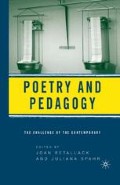Abstract
Shedding some light on Lyn Hejinian’s description of language as “strange matter,” Meg Simpson introduces her Poetic Epistemologies with the claim that “what makes [Hejinian’s] poetry so vital is that, by foregrounding the processes of language … [she] explores the relations among knowledge, language, and gender, thus (re)uniting art with philosophy ….”2 This in some measure clarifies Hejinian’s own playful-circular suggestion that poetry provides “the language of inquiry” into the self-conscious and yet self-effacing manner in which innovative language works. Experiencing poetry in the classroom, however, is another matter. To take Simpson’s epis-temic stance toward, or to find such a stance within, Hejinian’s writing seems somehow still at odds with many of the impulses behind her poetry and much of contemporary “challenging” poetry more generally.
That strange matter in which I’m bound
—Lyn Hejinian, The Cold of Poetry 1
Access this chapter
Tax calculation will be finalised at checkout
Purchases are for personal use only
Preview
Unable to display preview. Download preview PDF.
Notes
Lyn Hejinian, The Cold of Poetry (Los Angeles: Sun and Moon Press, 1994), 120.
Meg Simpson, Poetic Epistemologies: Gender and Knowing in Women’s Language-Oriented Writing (Albany: State University of New York Press, 2000), ix.
For his discussion of postmodern forms of intimacy available to contemporary poetry see Charles Altieri, “What Is Living and What Is Dead in American Postmodernism: Establishing the Contemporaneity of Some American Poetry,” Critical Inquiry AAA (Summer 1996), 764–789. For his exclusive discussion of Hejinian, see Charles Altieri, “Lyn Hejinian and the Possibilities of Postmodernism in Poetry,” in Women Poets of the Americas: Toward a Pan-American Gathering, ed. Brogan and Candelaria (Notre Dame: University of Notre Dame Press, 1999), 146–158,
David Antin, “Skypoems,” in Poetry Plastique, (New York: Granary Books, 2001), 94–96. Antin’s essay responds to twin photographs, taken by Phel Steinmetz (Poetry Plastique, 14—15) and originally on display at the “Poetry Plastique” exhibition in the Marianne Boesky Gallery, New York, which ran from February 9 to March 10, 2001. Antin himself arranged a featured skymes-sage: “They find it or leave it.”
Lyn Hejinian, Happily (Sausalito: The Post Apollo Press, 2000), 3.
Lyn Hejinian, The Cell (Los Angeles: Sun and Moon, 1992), 25.
Lyn Hejinian, “The Rejection of Closure,” in The Norton Anthology of Postmodern American Poetry, ed. Paul Hoover (New York: W.W., Norton, 1994), 654.
Lyn Hejinian, Writing Is an Aid to Memory (Los Angeles: Sun and Moon Press, 1996), 1.
Craig Dworkin, “Parting with Description,” in American Women Poets in the 21st Century: Where Lyric Meets Language, ed. Claudia Rankine and Juliana Spahr (Middletown: Wesleyan University Press, 2002), 242–265.
Jena Osman, The Character (Boston: Beacon Press, 1999). Fittingly, Jena Osman’s book of poetry is introduced by Lyn Hejinian, who, in reading it for Osman’s creative dissertation defense, actually played the character of several footnotes, along with Charles Bernstein.
Joan Retallack, The Poethtcal Wager (Berkeley: University of California Press, 2003), 23.
Lyn Hejinian, “A Local Strangeness,” in Some Other Frequency: Interviews with Innovative American Authors, ed. Larry McCaffery (Philadelphia: University of Pennsylvania Press, 1996), 136.
Kelly Oliver, “The Necessity and Impossibility of Witnessing,” Witnessing (Minneapolis: University of Minnesota Press, 2001), 85–106. Oliver comments on the communal yet presubjective character of the shared field of language, a condition for the possibility of an individualized perceptual field. Hejinian’s poem, “The Green,” in In the American Tree (Orono, Maine: The National Poetry Foundation, 1986; 2002), 57–59, intuits this field through her play on senses of the word “telling.” The poem begins, “I am nearsighted and therefore cannot tell, though I would, whether the shapes in a field across the road are rocks, or shrubs, or cows … I wouldn’t swear to all the details” (57). These same questionable grounds reappear in The Cell’s seemingly Wordsworthian “Words [that] are emitted by the / rocks to the eye” (entry for October 6, 1986), and the “boulders allowed among / the cows” (October 8, 1986). The boulders are “allowed” by poetic decree, it seems, as much as by increasing visual clarity.
For another Hejinian correspondence worth following, see Leslie Scalapino and Lyn Hejinian, Sight (Washington, D.C.: Edge Press, 1999). Charles Altieri thinks of Sight as an exploration of the way that friendship emerges between these two writers, out of their collective production of differences and their perception that feeling is primarily social, not egoistic. In this sense, Hejinian’s The Cell merits equally close attention, as an allegedly subjective text (a diary) that is in fact essentially turned outward, that is, dedicated to Kit Robinson,
Editor information
Copyright information
© 2006 Joan Retallack and Juliana Spahr
About this chapter
Cite this chapter
Keller, J. (2006). Language as Visible Vapor: Skywriting through Lyn Hejinian’s Happily . In: Retallack, J., Spahr, J. (eds) Poetry & Pedagogy. Palgrave Macmillan, New York. https://doi.org/10.1007/978-1-137-11449-5_15
Download citation
DOI: https://doi.org/10.1007/978-1-137-11449-5_15
Publisher Name: Palgrave Macmillan, New York
Print ISBN: 978-1-349-73492-4
Online ISBN: 978-1-137-11449-5
eBook Packages: Palgrave Social & Cultural Studies CollectionSocial Sciences (R0)

